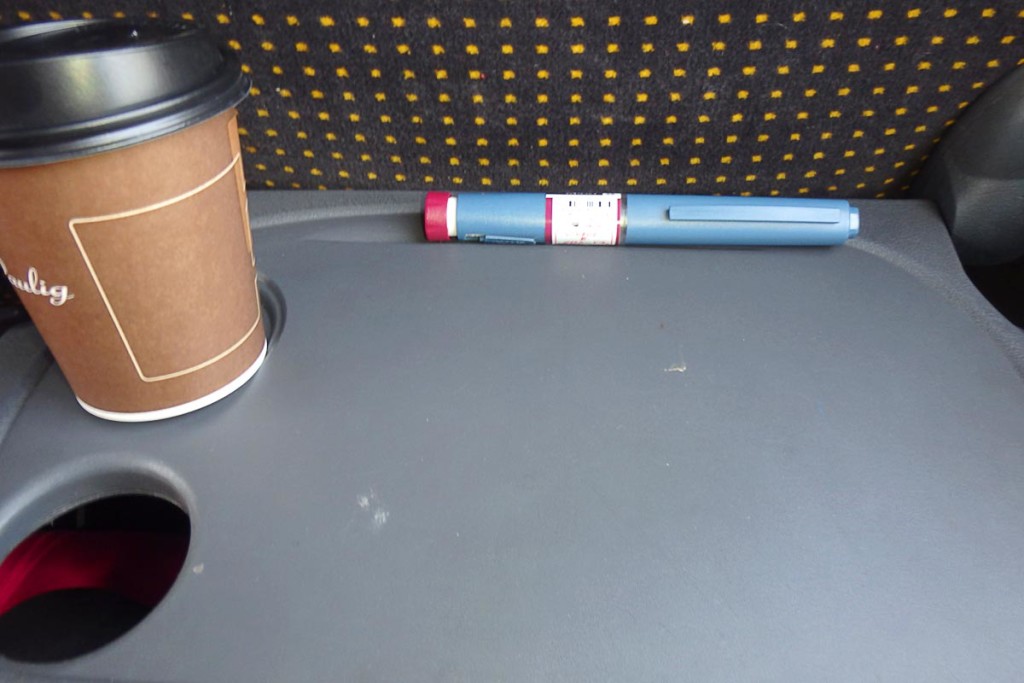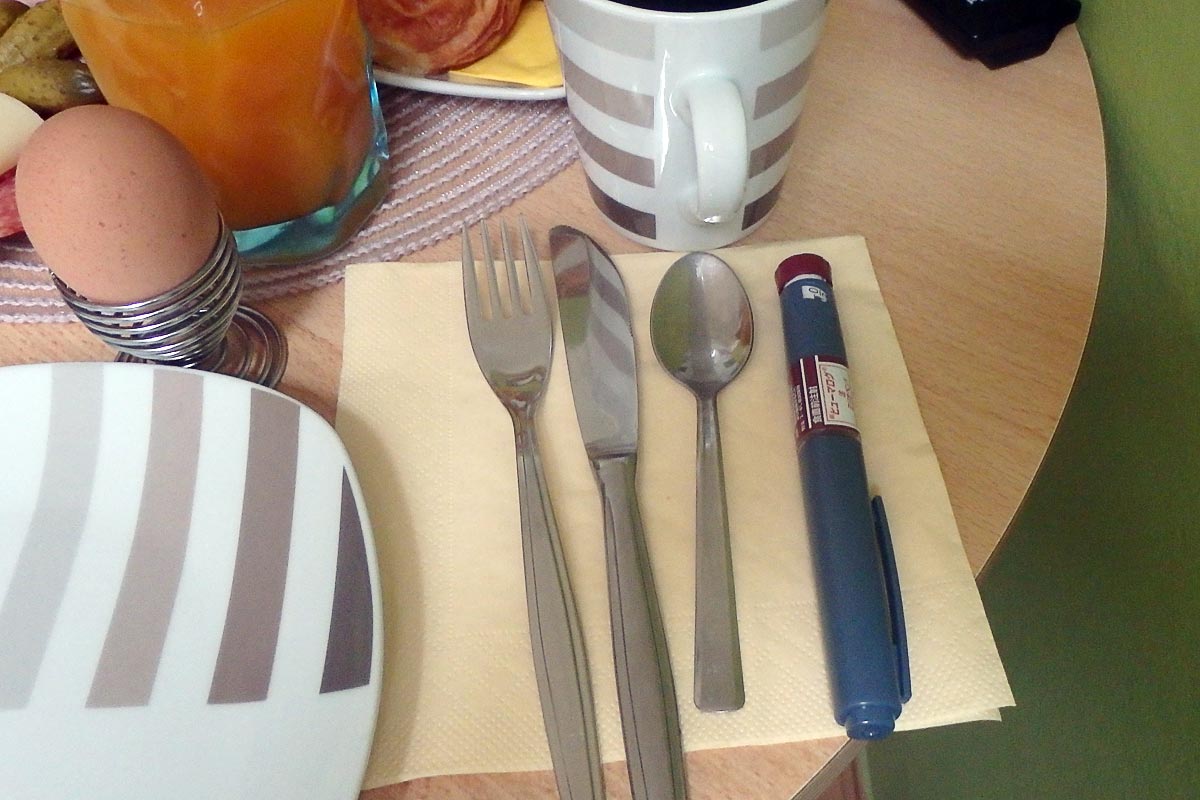
They've invented a new machine
The prettiest little thing you ever seen
—The Carolina Tar Heels
Some Type 1 diabetics use an insulin pump; some use pens or syringes. I have used pens and syringes since 1982, and I’m quite happy with them.
Despite other people – including diabetics, non-diabetics, even doctors – assuming I would like to start using one, I’m not interested in getting an insulin pump.

Humalog pen riding on an Estonian bus.
As I said in my article about continuous glucose monitors, there are quite a few differences between using and not using this type of technology. An insulin pump makes some things easier and some things harder.
It’s worth it to list the good points and bad points of an insulin pump. I think that pro-pumpers who are honest would have to admit that life with a pump isn’t all rosy and perfect – and they may be doing themselves a disservice in some ways by wearing one.

Breakfast in Ptuj, Slovenia.
What’s good about an insulin pump?
Many who pump love it. Many parents whose kids use pumps wouldn’t consider any other way. So what are the good points of a pump?
As far as I as a non-pumper can tell, benefits for diabetics who use an insulin pump can include:
- No needle jabs all the time. Just leave one needle in and it does its thing.
- Less calculating. Insulin doses and timings can be simplified.
- Reliability. You might forget your basal shot, but the pump never forgets.
- Less attention paid to diabetes. The pump does its thing in the background, allowing you to get on with your life.
Sounds pretty good when it’s listed like that. But I take exception to each of these points.

Dosing for baklava in Mostar, Bosnia and Herzegovina.
A point-by-point refutation
None of the above seem like great benefits to me, and here is why – a point-by-point response to the above list.
- You have to be punctured by a needle at all times. If you calculate “needle in flesh” time, the pump loses. I inject about 4-5 times a day; each one takes maybe 6 seconds. So I have a needle in me about 0.0003% of my time (three ten-thousandths of one percent). Pumpers? 100% of the time. No contest.
- You should know how to calculate. Leaving things to devices and computers may seem easy but there’s a cost. The closer you are to your diabetes day in and day out, the better equipped you are to manage it. Keeping things simple is a constant teacher: you eat this, you inject that, and you adjust based on the results. You’re not kept in the dark about what’s happening because you did everything yourself. The automatic functionality of pumps adds a potentially dangerous middleman between you and your body.

Insulin pen in Mexico: a little shot, then forgot.
- Unreliability. Pumps malfunction. Rarely, but not never. Pump needles and sites go bad without your knowing it at first. This point is related to the last one, but why let your brain soften in areas that might be generally helpful? If you only have yourself to rely on then you strengthen your mind, for diabetes and in general. Developing your own responsibility is a better idea than giving up and letting a machine do it. (And don’t get me started on car GPS systems!)
- More attention to diabetes. Again, this is an exact opposite of the supposed “benefit”, and depends on your perspective. When it’s meal time, or you feel low or high, or even when planning something, diabetes will be on your mind. At other times, it isn’t. But if you wear a pump at all times? A constant and unnecessary reminder. This can have negative psychological repercussions that people don’t realize, making diabetes seem bigger than it needs to.

Scenic shot in Dubrovnik, Croatia on the Adriatic Sea.
Which is best for you?
I wouldn’t recommend pump-using diabetics abandon theirs and switch to needles (and if I did nobody would or should listen), but I do think that the benefits of pumps are sometimes inflated in the quest for “easy” and “less stress”. I imagine pump-making companies are quite comfortable with this situation.
One of the many good points of diabetes is that it teaches you responsibility. Pumps remove a lot of that responsibility, and can make you feel like you’re hooked to some mini-machine from a hospital all the time.

Humalog pen and cake in Rīga, Latvia.
Maybe it’s because I’m such an inveterate traveler, but wearing a pump (or a CGM) all the time seems like a huge and wholly unnecessary hassle – a device that puts some distance between you and diabetes and comes with its own problems.
Thanks for reading. Suggested:
- Share:
- Read next: Is your traveling blood glucose monitor reliable?
- News: Newsletter (posted for free on Patreon every week)
- Support: Patreon (watch extended, ad-free videos and get other perks)

Support independent travel content
You can support my work via Patreon. Get early links to new videos, shout-outs in my videos, and other perks for as little as $1/month.
Your support helps me make more videos and bring you travels from interesting and lesser-known places. Join us! See details, perks, and support tiers at patreon.com/t1dwanderer. Thanks!

my pros and cons
http://insulinqueen.blogspot.co.uk/?zx=5a3e563ea64428ef
I’d like to read it but it says I’m not invited.
i’ll take it off private, whoops! 🙂
Thanks. Interesting article. Can you explain this “pro” more:
8. Delay/Skip Meals. If I did this on MDI the basal insulin would NEVER hold me steady. I’d have to eat whether I wanted to or not.
You mean you would get high if you skipped a meal? How is the pump different?
Yes, I would get high if I went any longer than 5 hrs without food (rare) as it seems the injected basal insulin just wasn’t strong enough to cope and the humalog for meals was masking this. With the pump as the basal is programmed to go in every hour at an amount I choose it just seems to work better. Having said that, if the infusion set is bad it doesn’t work at all and that is 9/10 at the moment! That blog is quit old and I feel much different now, perhaps I should do an updated version!
Ah so you’re pretty susceptible to not eating. That’s something I’ve noticed here too. If I don’t eat a big enough dinner I can end up high in the morning. Do you think it you got more exercise yours would be different? (I always think exercise fixes everything ^^)
Looking forward to your reignited blog 🙂
you’re right, exercise does help, loads. i walk between 7 -9 miles per day with my job and walking to and from work and that does help keep my doses and numbers down. 🙂
i think a good thing for me would be an iport. best of both worlds?
i tend to have to inject a lot as my body can’t cope with big meals, has to be little and often.
http://www.medtronicdiabetes.com/products/i-port-advance
Huh, I’d never seen this. So it stays in your skin for 3 days, and you just inject insulin into it huh. It does sound like a compromise that could benefit some people. Have you ever known or spoken with someone who used that?
Hello,
Interesting article ! I have been injecting since 45 years and maybe because of such a long time, I prefer to continue that way.
I don’t like the idea of having something attached to me all the time.
But when I talk with people who are using it, they say that they would never go back.
I guess the question is does it really improve your control.
Enjoy your travels, such an important part of life !
Thanks Céline. Having something attached to you all the time is indeed a big issue for many.
Someone told me on Facebook that they used a pump for 2 years and hated it. Went back to MDIs and lowered their A1C 1.5 points!
I am a pumper. Small insulin doses are hard to do by injection, and the pens are hard on my arthritic hands. Thus the pump is safer for me. Pumping is not bed of roses, but for me the pro’s outweigh the cons. I also use a CGM as I am hypoglycemic unaware.
I have had pump issues, and they are a pain, but still the pup is a safer road.
Thanks for the reply Denise. I’m glad you found that pumps work better for you. You mentioned that pump issues are a pain; pumps seem like “pain” in general to me 😉
Don’t want to be “strapped up” with a pump & CGM all the time. From what I’ve heard, costs are much higher as well. Manage with MDI & my meter just fine. Last 6 A1C tests were 6.5 or less so how much am I going to gain with a pump?
Exactly, Gary. Why be hooked to a machine when MDIs work just as well? Great job on the A1C!
Why not consider Afezza the inhalable insulin
Do you use Afrezza, Dave? What’s been your experience?